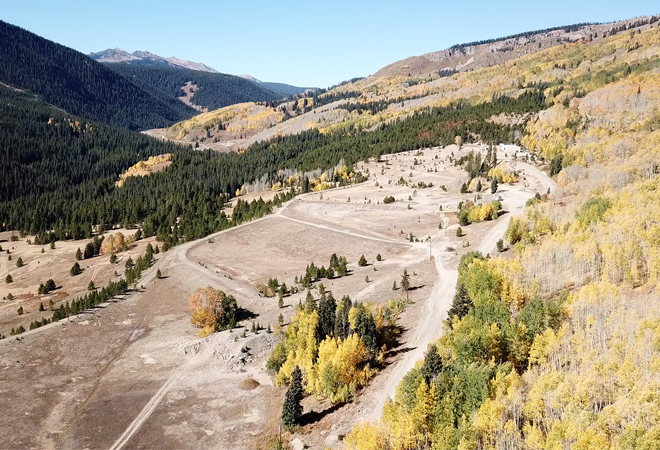Recent improvements, reclamation and water treatment studies
By Kendra Walker
If you’ve driven up Kebler Pass for leaf-peeping this fall or backcountry-skied Red Lady Bowl in the winter, you might have noticed the private driveway three miles west of Crested Butte on County Road 12—which leads to the Keystone Mine and fully operational water treatment plant nestled up on Mt. Emmons.
The plant has been treating mine-related water since it was built in the early 1980s and can treat up to 1,000 gallons of mine water per minute. The property was acquired by the Mt. Emmons Mining Company (MEMC), under the ownership of Freeport-McMoRan, in 2016.
Crested Butte town officials toured the water treatment plant on Friday, September 27 to learn updates from MEMC representatives about plant improvements from the past year, including reclamation projects and laboratory-scale water treatment studies.
Reclamation
The goal of mine reclamation is to restore the mined land back to a natural state and, specifically with the Keystone Mine, to improve the water quality of Coal Creek. Reclamation generally incorporates aspects relating to surface and groundwater quality, air quality, erosion concerns from storm-water, and the re-vegetation of plants and wildlife habitat.
“What we’re doing is managing history,” said Jim Telle, manager of external communications for Freeport-McMoRan.
He explained how the water runoff on Mt. Emmons compares to water percolating through your coffee grounds. It’s going to seep into the ground, as well as pick up mine metal materials as it continues to flow down—therefore affecting the integrity of the landscape and the water quality. MEMC has established various levels of drainage systems on the property to better mitigate the water, and has partnered with Trout Unlimited and the Colorado Division of Reclamation Mining and Safety (DRMS) with onsite reclamation.
These projects help divert clean water, such as storm water and snowmelt, around mineralized materials and reroute the water down the mountain through ditches and drop structures. The purpose is to successfully manage the clean water in order to minimize treatment. “We want to keep the clean water clean and reduce the amount that needs to be treated,” said Trout Unlimited project manager Jason Willis.
Natural materials are then applied to isolate the mine material from the water, which was accomplished at the Keystone Mine site with six inches of limestone capped with a 24-inch layer of soil and compost to promote plant growth.
“We’re pleased with how it all held together this year,” DRMS senior project manager/reclamation specialist Tara Tafi said about the re-vegetation process. “There were actually some flowers, too.”
Water treatment
This summer, MEMC initiated two pilot-scale studies to evaluate long-term water treatment alternatives to the aging water treatment plant.
The first study treats acidic, metal-laden mine water using high-density sludge technology. The process converts iron and manganese to less soluble, higher oxidation states to create a non-hazardous solid for landfill disposal. According to engineers at the site, this is the standard for producing high-density solids or sludge from mine discharges, and the study has already produced 20 percent solids. The crew plans to run the water study until November, analyze the data during the winter and use the data to evaluate the cost and benefits of a new water treatment plant.
The second pilot study is bioremediation, a biologically based water treatment system that uses a three-step process. The first step raises the water’s pH and introduces alkalinity in order to remove aluminum and iron, which adheres to limestone gravel the water passes through.
The water then flows to a sulfate-reducing biochemical reactor, relying on bacteria and organic materials such as woodchips, walnut shells and alfalfa hay to mediate the removal of metals, primarily copper and zinc.
Post-treatment, the water passes through vertical flow wetlands that have been installed at the site, which absorb the manganese from the water and transfer nutrients into the sediments. According to the crew, the wetland plants of sedge, grass and forb have held up well in the onsite environment, and the crew plans to stop water flow in the next month or so because of the potential for freezing pipes.
As winter approaches, MEMC will also work on repairs to re-vegetation work done in 2018, and will continue the operation of the water treatment plant and ongoing projects to improve storm-water management.
 The Crested Butte News Serving the Gunnison Valley since 1999
The Crested Butte News Serving the Gunnison Valley since 1999


